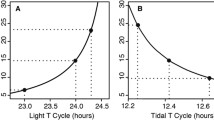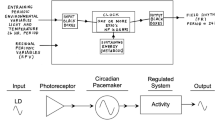Zusammenfassung
-
1.
Die circadiane Laufaktivität der dunkelaktiven SchabeBlaberus craniifer Burm. wird durch den Licht-Dunkel-Wechsel (LD) synchronisiert. Bei einem Phasensprung des Zeitgebers um 6 oder 12 Std durch Verlängern der Lichtzeit ist die Resynchronisationsgeschwindigkeit um so größer, je höher die Lichtintensität in der Hellzeit, d.h. je stärker der Zeitgeber ist (Abb. 1 und 3).
-
2.
Die Phasensprung-Versuche und eine modifizierte Inversion legen ein duales Steuersystem der circadianen Aktivität im LD-Wechsel nahe. Ein Zentrum reagiert unmittelbar auf Beleuchtungsänderungen, während sich das andere wie ein selbsterregter Oszillator verhält.
-
3.
Bei der Resynchronisation an den LD-Wechsel nach konstanten Bedingungen zeigte sich: Fällt der Aktivitätsbeginn bei Beginn des LD-Wechsels in die erste Hälfte der Dunkelzeit, erfolgt die Resynchronisation mit einer Periodenlänge τ<24 Std. Der Einfluß der Zeitgeberstärke bei Resynchronisation in der Dunkelzeit ist noch unklar. Fällt der Aktivitätsbeginn in die zweite Hälfte der Dunkelzeit oder in die Lichtzeit, erfolgt die Resynchronisation mit einem τ>Std. Der absolute Betrag von τ wird von der Lichtintensität in der Hellzeit bestimmt.
-
4.
Die Untersuchung sog. transient-Zyklen ergab: Beim Übergang vom Dauerdunkel zum Dauerlicht (LL) schießt die erste Periodenlänge meist über den neuen Wert hinaus. Der absolute Betrag hängt von der Lichtintensität im LL ab. Beim Übergang vom LL (1 Lux) zum LL (10 Lux) bzw. vom LL (10 Lux) zum DD übt der Grad der im LL erfahrenen Auflockerung des Aktivitätsblockes und im zweiten Fall die zeitliche Lage des LL-DD-Überganges zum Aktivitätszyklus einen starken Einfluß auf die Änderung der Periodenlänge aus.
-
5.
Die unter Punkt 3 und 4 zusammengefaßten Versuche geben weitere Hinweise für das Auftreten von Desynchronisationen im Steuer- system (vgl.Wobus, 1966).
Summary
-
1.
In the darkactive cockroachBlaberus craniifer Burm. the circadian rhythm of locomotor activity is synchronized by a light-darkcycle (LD). After a 6 or 12 hr phase jump of the „Zeitgeber“ caused by a prolongation of the light time, the circadian rhythm becomes resynchronized faster with increasing light intensities during light time (Fig. 1 and 3).
-
2.
Phase jumb experiments and a modified inversion suggest a dual control system of the circadian rhythm under LD conditions. One system reacts directly to changes in the light regime, the other acts as a self-sustained oscillator.
-
3.
A resynchronisation from constant to LD conditions shows the following: if the onset of activity happens to fall into the first half of the darktime of the first LD cycle, resynchronisation is achieved with a periodlength τ<24 hrs. The influence of the light intensity on the resynchronisation in the dark time is not yet clear. If the onset of activity happens to fall into the second half of the darktime or into the lighttime, resynchronisation is achieved with a τ>24 hrs. The exact value of τ is determined by the light intensity during lighttime.
-
4.
An analysis of so-called transient cycles reveals that the first cycle after the transition from DD to LL is longer in most cases than the following steady state cycles. The absolute value of τ depends on the light intensity in LL. The degree of dispersal of activity in LL is an important factor in the behaviour of the rhythm after transition from LL (1 lux) to LL (10 lux). The same is true for the phase relationship between the transition from LL (10 lux) to DD and the circadian rhythm.
-
5.
The experiments summed up under 3. and 4. give further evidence for the existence of desynchronisations in the control system (cf.Wobus, 1966).
Similar content being viewed by others
Literatur
Aschoff, J.: Exogenous and endogenous components in circadian rhythms. Cold Spr. Harb. Symp. quant. Biol.25, 11–28 (1960).
— (ed.): Circadian clocks. Amsterdam: North Holland Publ. Co. 1965a.
—: The phase-angle difference in circadian periodicity. In: Circadian clocks (J. Aschoff ed.), p. 262–276. Amsterdam: North Holland Publ. Co. 1965b.
—, u.R. Wever: Über Phasenbeziehungen zwischen biologischer Tagesperiodik und Zeitgeberperiodik. Z. vergl.Physiol.46, 115–128 (1962).
— —: Resynchronisation der Tagesperiodik von Vögeln nach Phasensprung des Zeitgebers. Z. vergl. Physiol.46, 321–335 (1963).
—,K. Klotter, andR. Wever: Circadian vocabulary. In: Circadian clocks (J. Aschoff ed.), p. X-XIX. Amsterdam: North Holland Publ. Co. 1956.
Birukow, G., u.E. Busch: Lichtkompaßorientierung beim WasserläuferVelia currens F. (Heteroptera) am Tage und zur Nachtzeit. II. Orientierungsrhythmik in verschiedenen Lichtbedingungen. Z. Tierpsychol.14, 184–207 (1957).
Brehm, E., u.G. Hempel: Untersuchung tagesperiodischer Aktivitätsschwankungen bei Käfern. Naturwissenschaften11, 265–266 (1952).
Brown jr., F. A., M. Fingerman, andM. N. Hines: A study of the mechanism involved in shifting of the phases of the endogenous daily rhythm by light stimuli. Biol. Bull.106, 308–317 (1954).
—, andH. M. Webb: Studies of the daily rhythmicity of the fiddler crab,Uca. Modifications by light. Physiol. Zool.22, 136–148 (1949).
Bünning, E.: Die physiologische Uhr, 2. Aufl. Berlin-Göttingen-Heidelberg: Springer 1963.
Fingerman, M., A. D. Lago, andM. E. Lowe: Rhythms of locomotor activity and O2-consumption of the grasshopperRomalea microptera. Amer. Midld. Naturalist59, 58–66 (1958).
Fischer, K.: Experimentelle Beeinflussung der inneren Uhr bei der Sonnenkompaßorientierung und der Laufaktivität vonLacerta viridis (Laur.). Naturwissenschaften47, 287–288 (1960).
Geisler, M.: Untersuchungen zur Tagesperiodik des MistkäfersGeotrupes sylvaticus Panz. Z. Tierpsychol.18, 389–420 (1961).
Harker, J.: Factors controlling the diurnal rhythm of activity ofPeriplaneta americana L. J. exp. Biol.33, 224–234 (1956).
—: The effect of perturbations in the environmental cycle of the diurnal rhythm of activity ofPeriplaneta americana L. J. exp. Biol.37, 154–163 (1960a).
—: Internal factors controlling the suboesophageal ganglion neurosecretory cycle inPeriplaneta americana. J. exp. Biol.37, 164–170 (1960b).
—: The physiology of diurnal rhythms. Cambridge: Cambridge University Press 1964.
Hoffmann, K.: Overt circadian frequencies and circadian rule. In: Circadian clocks (J. Aschoff ed.), p. 87–94. Amsterdam: North Holland Publ. Co. 1965.
Janda jr., V., u.M. Mrciak: Gesamtstoffwechsel der Insekten. VI. Die Bewegungsaktivität der SchabePeriplaneta americana L. während des Tages und ihre Beziehung zum Sauerstoffverbrauch. Věstn. čs. zool. Společ.21, 244–255 (1957) [Tschechisch mit Zus.fass.].
Kirchner, H.: Tageszeitliche Aktivitätsperiodik bei Carabiden. Z. vergl. Physiol.48, 385–399 (1964).
Lohmann, M.: Der Einfluß der Beleuchtungsstärke und Temperatur auf die tagesperiodische Laufaktivität des Mehlkäfers,Tenebrio molitor L. Z. vergl. Physiol.49, 341–389 (1964).
Mori, S.: Influence of environmental and physiological factors on the daily rhythmic activity of a sea-pen. Cold Spr. Harb. Symp. quant. Biol.25, 333–344 (1960).
Mothes, G.: Weitere Untersuchungen über den physiologischen Farbwechsel vonCarausius morosus (Br.). Zool. Jb. Abt. allg. Zool. u. Physiol.69, 133–162 (1960).
Pittendrigh, C. S., andV. G. Bruce: An oscillator model for biological clocks. In: Rhythmic and synthetic processes in growth (D. Rudnick ed.), p. 75–109. Princeton: Princeton Univ. Press 1957.
— —, andP. Kaus: On the significance of transients in daily rhythms. Proc. nat. Acad. Sci. (Wash.)44, 965–973 (1958).
—, andD. H. Minis: The entrainment of circadian oscillations by light and their role as photoperiodic clocks. Amer. Naturalist98, 261–294 (1964).
Remmert, H.: Biologische Periodik. In:L. v. Bertalanffy, Handbuch der Biologie, Bd. V, S. 335–411. Frankfurt a.M.: Akad. Verlagsges. Athenaion 1965.
Rensing, L.: Aktivitätsperiodik des WasserläufersVelia currens F. Z. vergl. Physiol.44, 292–322 (1961).
Roberts, S. K.: Significance of endocrines and central nervous system in circadian rhythms. In: Circadian clocks (J. Aschoff ed.), p. 198–213. Amsterdam: North Holland Publ. Co. 1965.
Sollberger, A.: Biological rhythm research. Amsterdam-London-New York: Elsevier Publ. Co. 1965.
Tongiorgi, P.: Effects of the reversal of the rhythm of nycthemeral illumination on astronomical orientation and diurnal activity inArctosa variana Cl. Koch. Arch. ital. Biol.97, 251–265 (1959).
Wever, R.: A mathematical model for circadian rhythms. In: Circadian clocks (J. Aschoff ed.), p. 47–63. Amsterdam: North Holland Publ. Co. 1965a.
—: Einzel-Organismen und Populationen im circadianen Experiment. Z. vergl. Physiol.51, 1–24 (1965b).
Wobus, U.: Der Einfluß der Lichtintensität auf die circadiane Laufaktivität der SchabeBlaberus craniifer Burm. (Insecta:Blattariae). Biol. Zbl.85, 305–323 (1966).
Author information
Authors and Affiliations
Additional information
Herrn Prof. Dr.G. Tembrock danke ich für die Überlassung des Themas und wertvolle Anregungen.
Rights and permissions
About this article
Cite this article
Wobus, U. Der Einfluss der Lichtintensität auf die Resynchronisation der circadianen Laufaktivität der SchabeBlaberus craniifer Burm. (Insecta: Blattariae). Z. Vergl. Physiol. 52, 276–289 (1966). https://doi.org/10.1007/BF02427713
Received:
Issue Date:
DOI: https://doi.org/10.1007/BF02427713




